2023 Annual Report for: Sphingidae / Macroglossinae
For species seen in 2023 that had less than or equal to 100 records, full details are included; for more common species, the earliest, latest and highest count by vice-county are shown. The narrative for each species is taken from the main Hantsmoths website, and it is possible that some information on abundance and occurrence can get out of date, as it is impossible to keep up with all changes; however it should give a good introduction to each species. The tables in each species account summarise the previous status, and that for the current year.
For the maps, all records prior to 2023 are shown by a blue dot (the larger the dot, the more recent), with the current year's records shown in red. As previous records are superimposed on any report for 2023, new sites have greater emphasis (i.e. will show as 'more red').
In the species accounts, an asterisk next to a location indicates a new 10km square record; earliest ever dates are highlighted in orange, and latest ever in red. Initials in the species accounts refer to the recorders listed here. Please get in touch if you identify any omissions or errors, in particular if you have records that have yet to be submitted. Details of how to submit records can be found here.
69.008 [B&F: 1982] Narrow-bordered Bee Hawk-moth Hemaris tityus (Linnaeus, 1758) - Na
Nationally scarce (Nb) on unimproved calcareous grassland and chalk downland in south-western England, with scattered colonies in northern England, Wales and western Scotland, a priority species under the UK Biodiversity Action Plan. In Hampshire and on the Isle of Wight formerly local and moderately common, now much reduced in numbers, and there was no sighting on the Isle of Wight since 1950 until one turned up in 2014. It is still reasonably frequent on Martin Down and is seen from time to time at sites such as Botley and Bentley Woods. Wingspan 41-46 mm. The most likely confusion species is Broad-bordered Bee Hawk H. fuciformis, which has a large brown discal spot and a broader terminal fascia on the forewing, and reddish bands on the abdomen compared to two blackish bands for tityus. Larva feeds on Devil's-bit Scabious, Small Scabious and Field Scabious, over-wintering as a pupa.
Records prior to 2023
| Vice County | #Records | #Individuals | First Record | Last Record |
|---|---|---|---|---|
| 10 | 8 | 1 | 1856 | 2014 |
| 11 | 56 | 33 | 1800 | 2021 |
| 12 | 23 | 22 | 1800 | 2022 |
2023 records
| Vice County | #Records | #Individuals | Max Quantity |
|---|---|---|---|
| 11 | 6 | 42 | 25 |
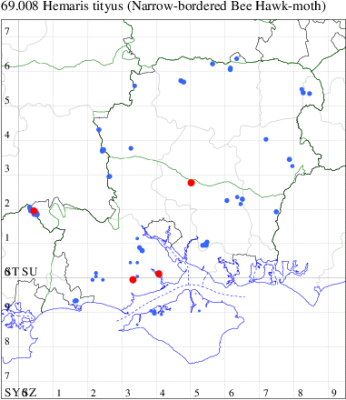
Records by year
Records by week (adult)
Records by week (larval)
Record Details
VC11: Bransgore, five, field observation, 01 Jun (SPMC); Sims Wood, North Solent NNR*, three, field observation, 14 May (HBoy det. AJB); Deacon Hill*, one, field observation, 24 May (AJB, CRB); Bransgore, 25, field observation, 26 May (SPMC, PRD, JRD); five, field observation, 28 May (SPMC)
69.009 [B&F: 1983] Broad-bordered Bee Hawk-moth Hemaris fuciformis (Linnaeus, 1758) - Nb
Nationally scarce (Nb) along woodland margins and on heathland in England and Wales. In Hampshire and on the Isle of Wight, has recovered from a low level in the 1970s; the species is reported occasionally, with the main population occurring in the New Forest. Wingspan 46-52 mm. The most likely confusion species is Narrow-bordered Bee Hawk H. tityus, which see for differences. Larva feeds on Honeysuckle, over-wintering as a pupa.
Records prior to 2023
| Vice County | #Records | #Individuals | First Record | Last Record |
|---|---|---|---|---|
| 10 | 7 | 1 | 1800 | 1951 |
| 11 | 155 | 152 | 1800 | 2022 |
| 12 | 65 | 48 | 1800 | 2022 |
2023 records
| Vice County | #Records | #Individuals | Max Quantity |
|---|---|---|---|
| 11 | 2 | 2 | 1 |
| 12 | 8 | 11 | 4 |

Records by year
Records by week (adult)
Records by week (larval)
Record Details
VC11: Hurn, one, field observation, 28 Jul (MJef); Hengistbury Head, one, 31 May (BKin det. MJef);
VC12: Whitehill, one, field observation29 May; one, field observation, 04 Jun; one, field observation, 14 Jun; one, field observation, 20 Jun (ASto); Ancells Farm HWT reserve, larva, four, field observation, 27 Jun; Fleet Pond, larva, one, field observation, single larva - 3rd instar, 03 Aug (MHals); Southwood Woodlands, Rushmoor, one, field observation, 25 Jul (MThmp)
69.010 [B&F: 1984] Humming-bird Hawk-moth Macroglossum stellatarum (Linnaeus, 1758) - Migrant
Common immigrant from southern Europe, appearing throughout the British Isles, in some years arriving in sufficient numbers to breed. In Hampshire and on the Isle of Wight appears annually in varying numbers, and on average increasing year on year. Has been recorded in winter, and is known to hibernate, and therefore spring records likely refer to overwintering individuals rather than new immigrants. Wingspan 50-58 mm. An unmistakable diurnal moth, which hovers to nectar from the flowers of many plant species, amongst which are Aubrieta, Buddleia, Viper's Bugloss Echium vulgare, Red Valerian Centranthus ruber, Honeysuckle Lonicera, Nepeta, Petunia, Jasminum and Pulmonaria. Larva feeds on Lady's Bedstraw, Hedge Bedstraw and Wild Madder.
Records prior to 2023
| Vice County | #Records | #Individuals | First Record | Last Record |
|---|---|---|---|---|
| 10 | 1290 | 1705 | 1849 | 2022 |
| 11 | 1992 | 2078 | 1946 | 2022 |
| 12 | 1221 | 1391 | 1951 | 2022 |
2023 records
| Vice County | #Records | #Individuals | Max Quantity |
|---|---|---|---|
| 11 | 193 | 190 | 2 |
| 12 | 113 | 117 | 4 |
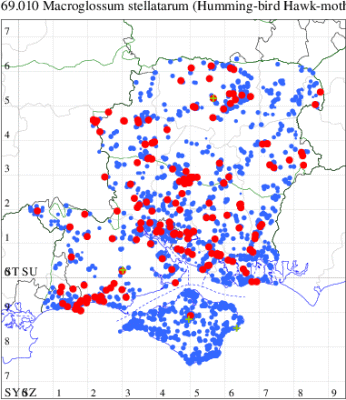
Records by year
Records by week (adult)
Records by week (larval)
Record Summary
VC10: Earliest: Newport, 28 Sep, 1 (BClo) Max count: Newport, 28 Sep, 1 (BClo)
VC11: Earliest: Winchester College, 19 Jan, 1 (ECav) Latest: Fareham, 03 Dec, 1 (KJW) Max count: Hinton Ampner, 04 Aug, 2 (AJB, LB)
VC12: Earliest: Kempshott, Basingstoke, 24 Mar, 1 (PWar) Latest: Whitehill, 20 Nov, 1 (ASto) Max count: Shipton Bellinger, 01 Aug, 4 (CWoo)
69.014 [B&F: 1987] Bedstraw Hawk-moth Hyles gallii (Rottemburg, 1775) - Nationally Rare
Immigrant from southern Europe, appearing almost anywhere in Britain, but mostly in the south and east, in some years arriving in sufficient numbers to breed and perhaps now established in East Anglia. There are scattered records throughout Hampshire and the Isle of Wight, with the most northerly being one at Sherborne St John in August 2003. Wingspan 64-78 mm. The most likely confusion species is Spurge Hawk-moth H. euphorbiae, which see for differences. Larva feeds on Wild Madder, Rosebay Willowherb and various species of bedstraw, perhaps unable to survive cold winters in the United Kingdom.
Records prior to 2023
| Vice County | #Records | #Individuals | First Record | Last Record |
|---|---|---|---|---|
| 10 | 13 | 17 | 1859 | 2021 |
| 11 | 30 | 49 | 1937 | 2021 |
| 12 | 12 | 12 | 1952 | 2014 |
2023 records
| Vice County | #Records | #Individuals | Max Quantity |
|---|---|---|---|
| 11 | 1 | 1 | 1 |
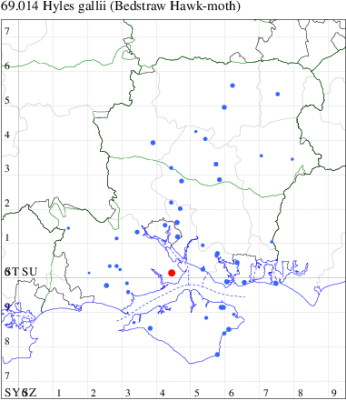
Records by year
Records by week (adult)
Records by week (larval)
Record Details
VC11: Blackfield*, one, 09 Aug (SJJ)
69.015 [B&F: 1990] Striped Hawk-moth Hyles livornica (Esper, [1804]) - Migrant
An immigrant species from southern Europe or even northern Africa, where it frequents open woodland habitats. In Hampshire and on the Isle of Wight occurs almost annually in ones and twos, however in 1949 it appeared in unprecedented numbers, and 2006, probably the most memorable 'migrant year' in recent memory, saw 26 records across our two counties: sightings can be expected to increase, and has potential to become at least temporarily established. Wingspan 78-90 mm. Very similar to the extremely rare White-lined Hawk-moth H. lineata, which see for differences. Larva feeds on Willowherb and Bedstraw, formerly unable to over-winter in significant numbers but this is likely to change due to the impact of the climate emergency.
Records prior to 2023
| Vice County | #Records | #Individuals | First Record | Last Record |
|---|---|---|---|---|
| 10 | 42 | 38 | 1800 | 2022 |
| 11 | 61 | 56 | 1800 | 2022 |
| 12 | 10 | 5 | 1800 | 2012 |
2023 records
| Vice County | #Records | #Individuals | Max Quantity |
|---|---|---|---|
| 11 | 2 | 1 | 1 |
| 12 | 2 | 2 | 1 |
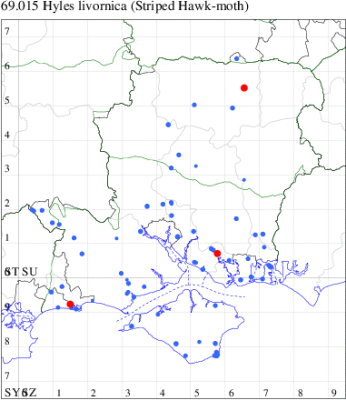
Records by year
Records by week (adult)
Records by week (larval)
Record Details
VC11: Fareham, one, 27 Jul (KJW); Christchurch, present, 14 May (APard);
VC12: Longparish*, larva, one, field observation, 21 Jun (CSwe det. GCE); Chineham, Basingstoke*, one, field observation, 14 May (CHarr)
69.016 [B&F: 1991] Elephant Hawk-moth Deilephila elpenor (Linnaeus, 1758) - Common
Common in hedgerows, gardens, woodland edges and heathland, and on rough grassland and sand-dunes throughout England, Wales and southern Scotland. Widely distributed and occasionally abundant throughout Hampshire and on the Isle of Wight. Wingspan 62-72 mm. Small Elephant Hawk-moth D. porcellus is superficially similar, but smaller, with forewing yellow and pink, not olive-green and pink. Larva feeds on Rosebay Willowherb, Great Willowherb, Lady's Bedstraw, Hedge Bedstraw, Heath Bedstraw and Marsh Bedstraw, over-wintering as a pupa.
Records prior to 2023
| Vice County | #Records | #Individuals | First Record | Last Record |
|---|---|---|---|---|
| 10 | 1408 | 4428 | 1951 | 2022 |
| 11 | 10490 | 24523 | 1949 | 2022 |
| 12 | 2959 | 6738 | 1951 | 2022 |
2023 records
| Vice County | #Records | #Individuals | Max Quantity |
|---|---|---|---|
| 11 | 284 | 434 | 12 |
| 12 | 132 | 215 | 8 |
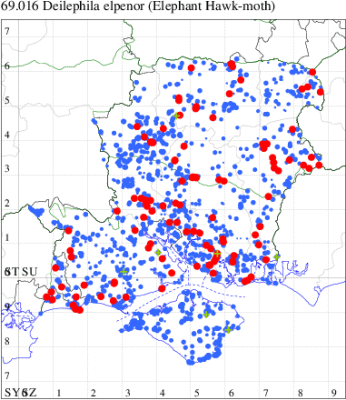
Records by year
Records by week (adult)
Records by week (larval)
Record Summary
VC11: Earliest: Fareham, 24 May, 1 (MLO) Latest: Old Milton, 25 Oct, 1 (BLor) Max count: Fishlake Meadows, 13 Jul, 12 (NRJ)
VC12: Earliest: Windmill Hill, Chalton, 07 Jun, 1 (CJP) Latest: Willow's Green Inclosure, Alice Holt Forest, 16 Sep, 0 (iNat) Max count: Overton, 17 Jun, 8 (ACr)
69.017 [B&F: 1992] Small Elephant Hawk-moth Deilephila porcellus (Linnaeus, 1758) - Local
Local in calcareous grassland, chalk downland, heathland, sand-dunes, shingle beaches and damp grassland throughout much of England and Wales. In Hampshire and on the Isle of Wight still common on chalk downland, and also occurs on coastal shingle and sandhills, with occasional wanderers elsewhere. Wingspan 47-56 mm. Elephant Hawk-moth D. porcellus is superficially similar, but larger, with forewing olive-green and pink, not yellow and pink. Larva feeds on Lady's Bedstraw, Hedge Bedstraw, Heath Bedstraw, Marsh Bedstraw, Rosebay Willowherb and Purple Loosestrife, over-wintering as a pupa.
Records prior to 2023
| Vice County | #Records | #Individuals | First Record | Last Record |
|---|---|---|---|---|
| 10 | 563 | 1734 | 1849 | 2022 |
| 11 | 1525 | 2545 | 1700 | 2022 |
| 12 | 924 | 1814 | 1948 | 2022 |
2023 records
| Vice County | #Records | #Individuals | Max Quantity |
|---|---|---|---|
| 11 | 58 | 103 | 18 |
| 12 | 40 | 137 | 35 |

Records by year
Records by week (adult)
Records by week (larval)
Record Details
VC11: Blashford Lakes HIWWT NR, one, 10 Jun (PWhtk); Marchwood, one, 17 Jun; Lee, three, 17 Jun (CTha); North Baddesley, one, 12 Jun (RWPas); Romsey, one, 26 Jun (MJB); Broughton, two, 23 Jun (GCE); Dibden Purlieu, NF, one, 12 Jun; one, 16 Jun (RAC); Winchester, four, 16 Jun (THW); Brownwich Cliffs, Titchfield, one, 07 Jul (F.M.G.); Stubbington, one, 10 Jun (DPH); Fareham, one, 14 Jun (ADT); two, 21 Jun (IMcP); one, 21 Jun (MLO); one, 19 Jun (KJW); Dean, Bishop's Waltham, present, 19 Jun (CMor); Wickham, one, 23 Jun (F.M.G.); one, 12 Jun (JRDS); Horsea Island, 18, 16 Jun (F.M.G.); Portsmouth, one, 16 Jun; one, 25 Jun; one, 27 Jun (IRT); Horndean, one, 10 Jun; one, 12 Jun; one, 16 Jun; one, 17 Jun; four, 23 Jun (PHog); Clanfield, two, 27 Jun (MBer); Muscliffe, one, 21 Jun; four, 27 Jun; one, 18 Jul (KingB); Hengistbury Head, one, 12 Jun; one, 12 Jun; one, 18 Jun; two, 19 Jun; one, 20 Jun; one, 21 Jun; four, 26 Jun; one, 27 Jun; two, 28 Jun; one, 02 Jul; one, 03 Jul; one, 27 Jun (MJef); Sway, one, 13 Jun; one, 18 Jun; one, 21 Jun (SKee); Sway, NF, present, 16 Jun (DMui); Pennington, one, 05 Jun; one, 09 Jun; two, 17 Jun (RFC); Lymington, NF, one, 28 Jun; one, 05 Jul (JWar); Southsea, one, 06 Jun; one, 20 Jun (JGdr);
VC12: Cholderton, two, 29 Jul (TJN); Chilbolton, five, 23 Jun; two, 01 Jul (GCE); The Hawk Conservancy, Weyhill, present, field observation, 10 Jun (iNat); Goodworth Clatford, two, 01 Jul (TJN); Vernham Dean, one, 12 Jun (JHale); Littleton, one, 27 Jun; one, 27 Jun; Wonston, one, 16 Jun; one, 16 Jun; one, 16 Jun (GCE); Whitchurch, three, 22 Jun (SuBro); Magdalen Hill Down NNR, 10, 10 Jun (KArb, SIng, PPea); two, 27 May (KArb, SIng, PPea, MEdg); one, 24 Jun (KArb, ARho, PPea); two, 07 Jul (SIng, NRJ, PPea); Morn Hill, Winchester, 35, 10 Jun (CRB, DAS, PDF et al); 35, 10 Jun (CRB, PDF, DAS, LHur); 11, 24 Jun (CRB, PDF, DAS); Overton, one, 09 Jun; one, 14 Jun; one, 17 Jun (ACr); North Waltham, one, 10 Jun; one, 16 Jun; one, 27 Jun; one, 07 Jul (AJon); Basingstoke, one, 09 Jun (MJW); Alton, one, 08 Jun; two, 13 Jun; one, 15 Jun; one, 23 Jun (DBO); Windmill Hill, Chalton, one, 04 Jun; one, 10 Jun; one, 11 Jun; one, 15 Jun; one, 07 Jul (CJP); Noar Hill HIWWT NR, Selborne, present, several, 09 Jun (AMD, FHay det. AMD); Whitehill, one, 17 Jun (ASto); Liphook, one, 16 Jun (SEP); Blackwater, one, 10 Jun (BGD)
69.018 [B&F: 1993] Silver-striped Hawk-moth Hippotion celerio (Linnaeus, 1758) - Migrant
Rare immigrant from mainland Europe, appearing throughout England and, occasionally, southern Scotland. Absent in many years, but numbers have exceeded ten in several years: 1865, 1868, 1885 (when 41 were recorded) and 1963. In Hampshire and on the Isle of Wight singletons have appeared in ten of the last fifty years, with two in 1978. Wingspan 72-80 mm. Fairly unmistakable. Larva feeds on Lady's Bedstraw, Great Willowherb and Honeysuckle, no evidence of breeding in the UK.
Records prior to 2023
| Vice County | #Records | #Individuals | First Record | Last Record |
|---|---|---|---|---|
| 10 | 5 | 5 | 1834 | 2017 |
| 11 | 16 | 16 | 1877 | 2022 |
| 12 | 6 | 6 | 1943 | 1977 |
2023 records
| Vice County | #Records | #Individuals | Max Quantity |
|---|---|---|---|
| 11 | 1 | 1 | 1 |
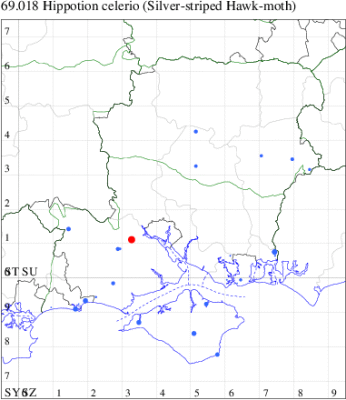
Records by year
Records by week (adult)
Records by week (larval)
Record Details
VC11: Woodlands, NF*, one, 11 Sep (CyJon)





